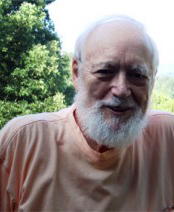by Hugh Courtney, 2019 Celestial Planting Calendar
When do trees become a wood or woods and ultimately a forest? To answer this question, we can use a dictionary, in this case, The Random House Dictionary.
A tree is “a plant having a permanently woody main stem or trunk ordinarily growing to a considerable height and usually developing branches at some distance from the ground.”
The definition of woods or wood is described as “a large and thick collection of growing trees, a grove or forest.”

When we examine the word forest, it is defined as, “a large tract of land covered with trees and underbrush.”
When we try to sort out the difference between forest, grove and woods, we understand that all these terms refer to an area covered with trees.
These definitions do not take us to a real understanding but lead us in circular directions. It’s no wonder that such sayings as “I can’t see the forest for the trees,” and, “I can’t see the trees for the forest” continue to permeate our way of speaking.
To remedy this lack of understanding, it may be useful to look at trees from a spiritual perspective rather than merely from a physical aspect. For that spiritual view, let us turn to Rudolf Steiner’s Agriculture Course, most specifically, the Adams translation. Steiner’s insights on the role of trees in nature are both numerous and eye opening. Before detailing some of those insights, it is helpful to review some of the terms he uses.
He describes nature as consisting of four basic kingdoms, each of which adds a particular physical quality and/or spiritual aspect. The Mineral Kingdom presents only the realm of physical substance here on Earth. The Plant Kingdom adds the quality of livingness or life, or to use Steiner’s term, the plant possesses an etheric body as well as a physical body. When we look at the Animal Kingdom, in addition to a physical and a life body, a soul or an astral body is included which brings forward the qualities of movement and feeling. The fourth kingdom of Nature, the Human Kingdom, adds a spiritual or ego body to the other three bodies. It is this body which allows us to express a unique individuality or personality here on Earth.
This view conflicts with the Darwinian concept of the human being as a mere higher animal. Steiner’s view raises humans to a level of spiritual importance in the universe. Perhaps, also, that view repositions Planet Earth from a mere speck in a vast cosmos to a unique experiment of an entire hierarchy of spiritual beings.
With this brief introduction to Steiner’s vocabulary, let us return to his description of the importance of trees in Nature. We are given a special glimpse into the nature of trees in his seventh lecture of the Agriculture Course delivered on June 15, 1924. Steiner reminds us to view the subject from a macrocosmic perspective rather than a microcosmic one, and in particular, that we understand that within Nature everything is connected with everything else.
To help us better understand the unique expression of trees, Steiner asks us to grasp that the buds, leaves, flowers and fruit on a tree exist with a root as well. He suggests that plants growing out of the soil essentially share a common root below the soil. In the tree, which he tells us to view as though it were earth heaped up, the root zone for what grows out of the tree is actually the cambium layer. The cambium layer is analogous to the common root zone shared by herbaceous plants underneath the soil.
Steiner goes on to describe trees—particularly fruit and deciduous trees—as “gatherers of astral substance.” That astral substance expresses itself specifically through the world of insects in the form of beings, such as butterflies, bees, other flying insects and birds. Steiner then embarks on a wide-ranging description of the myriad interconnections within nature that would not happen if there were no trees. The amazing spiritual insights he provides puts trees in a category by themselves, to the extent that trees can almost be seen as a separate kingdom of nature, residing somewhere between the plant kingdom and the animal kingdom.
Indeed, if we look to the Chinese system of elements, we find five elements labeled as Fire, Earth, Water, Metal and Wood. This is in contrast to the system we are accustomed to in the western world with the four elements, namely Fire, Earth, Air and Water.
Through the unique function of the cambium layer within trees, Steiner goes on to say, “a relative poverty of ether is engendered in the tree, [which] makes the earthly soil rather more dead in the environment of the tree.” Without the rich astrality in the tree tops, the insect world would not exist. Without the poverty of ether in the vicinity of tree roots, the larval stage of the insect world would not exist. Ultimately the earthworm is able to regulate the vitality in the Earth. Without trees and the refined etheric body within the cambium layer, no birds, butterflies, insects and earthworms would be present. He states that “the regulation of woods and forests is an essential part of agriculture.”
At a certain point, Steiner indicates that “a regular division of labor between the bird world and the butterfly world” has come about in that the world of herbaceous plants and shrubs is served by “the butterfly world and the whole realm of trees is served by the bird world.”
From a somewhat distinct perspective, I also need to quote from Karsten Massei’s book, School of Elemental Beings, on page 36, where he explains the role of trees in relation to the elemental beings, “The trees are extremely important for the beings of the elemental world. Elemental meetings take place under the vaulted and peaceful roof of the trees, during which they receive instructions from higher beings. Trees also stand between the other world and this one. This is connected with the substance of wood. The living wood is the substantial foundation for the other world and this world meeting in the trees. The fact that trees stand at this threshold of worlds is also the reason that very specific elemental beings are born in the trees.”
 Hugh Courtney - Writer, Mentor, Teacher, Researcher Hugh Courtney - Writer, Mentor, Teacher, Researcher
In addition to contributing articles, Hugh Courtney has taken on the advisory role of forecasting favourable and unfavorable times for this calendar. He has devoted more than 40 years to perfecting the art of making biodynamic preparations. Taking a cue from his own mentor, Josephine Porter, who declared, “These preparations are no secret, I will teach anyone who wants to learn how to make them,” he has mentored hundreds of people on the finer points of making quality preparations.
Ever concerned about keeping this special art form alive into the future, in 2009, Hugh founded Earth Legacy Agriculture, LLC to provide quality preparations for discerning practitioners. www.earthlegacyagriculture.com
|


![]()


 Hugh Courtney - Writer, Mentor, Teacher, Researcher
Hugh Courtney - Writer, Mentor, Teacher, Researcher